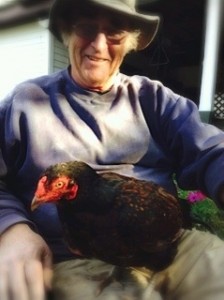This chicken thinks she’s a cat. Find out what other impossible things can happen on this unconventional farm.
On Thursday, Mom and Dad sit down on the back porch to listen to the chorus of afternoon crickets. Mom’s cat, Tayla, hops into her lap. Dad’s cat, Strawberry, hops into his. Tayla has long calico fur. Strawberry has feathers.
When Strawberry first came to us, we mistook her for a chicken. Most people do. Her beak, comb and scaly feet could fool anyone. But Strawberry knew her true identity, and patiently corrected us over her years at Sap Bush Hollow. Eventually, we came to understand that she had no place in the chicken coop, and no place out in the fenced-in pasture with the other birds. Strawberry roams the farm freely, but like any typical cat, prefers to keep to the back porch. Like a chicken, she ovulates almost daily, leaving eggs in unlikely places — in Dad’s feed buckets, in the kindling box, beneath the brake pedal of the truck. She never acknowledges these eggs. They are forgotten symptoms of a former identity. Like a true cat, she denies any part of her reality with which she does not agree. Mom has learned to look out for them, to gather them up without chastising Strawberry; just as she patiently cleans up the droppings Strawberry periodically leaves by the back door (she has not learned to use a litter box). She is, however, our best mouser.
Strawberry is not the only creature on our farm who created a new reality for herself. Confit looked like a mallard duck, but she mated with Foie Gras, a goose. Like geese, they were a pair for life, and Foie Gras never (that we know of) questioned her identity. She laid eggs every spring, and he guarded her while she sat on them, waiting for them to hatch. They never did, but neither Confit nor Foie Gras allowed that little fact to come between them.
Isabelle was born to one of our breeding ewes one May, but after the death of her mother, recognized her true identity as a dog. She does not run away when we try to herd her. She follows us, just like the border collies, through gates and across fields. She has never been much of a breeding ewe, but like a good dog, she has proven excellent at helping us to move the flock.
And let’s not get started on the dogs, who believe they are people…
As I watch Mom and Dad sit nonchalantly with Strawberry and Tayla, I observe how our family doesn’t challenge the behaviors of these extraordinary animals. Many creatures pass in and out of our lives, and there are always a few who prove themselves noteworthy in some way. We accept them for who they are, granting them permanent amnesty from the chopping block and processing room. These prodigious critters occupy my mind on Sunday when Saoirse and I drive over to visit Aunt Kimmie.
Aunt Kimmie and Uncle Tommy inherited my grandfather’s sheep farm. It came with a three story stone house built in 1789 on one side of a state highway, and three hundred acres of stunning farmland on the other. They came up from New Jersey and moved in with Grandpa at the end of his life. Tommy ran the farm and saw to Grandpa’s needs during the day, trading off hours with my dad and my Aunt Katie. Kimmie accepted night duty and took care of Grandpa through his long sleepless episodes. But a giant stone house and a three hundred acre farm are more work than they bargained for.
I know she is overwhelmed. They love the land, but I know this giant house was nothing she wanted. I know she feels like she can never get ahead of it. Tougher still, Aunt Kimmie is a tropical fish in a trout stream. The upstate bugs frighten her. When she receives the smallest bite, her skin develops welts, her lymph nodes swell, her ears fill with fluid. She tolerates my family’s pragmatic ways — our culture of meat, butchery, and animal husbandry. But she is from a different world.
Kimmie couldn’t be more than five foot two, with full feminine curves. She is a baritone with a Jersey accent. “Dere’s ghosts in this house like you wouldn’t believe,” she confided to me in her deep voice one afternoon, as Saoirse and I lead her to a sunny corner of the kitchen for tea. She squints her eyes and leans across the table. “They watch my programs with me.”
“They watch TV with you?” I clarify, my eyes wide.
“Yeah. You know, like Dead Files, or Ghost Adventures. They stand around the corner, there in the hallway,” she points. “I tell ‘em, ‘Don’t get any ideas!’” She pauses, her fingers twitching for a cigarette. She refuses to smoke in the house, but she fears going out to the realm of the insects. “They’re not so bad, though. Sometimes they help me when I can’t remember where I left my coffee cup.”
Saoirse’s eyes are bugging out of her head in excitement. “Aunt Kimmie!” She exclaims. “You’ve actually seen ghosts?”
She shrugs. “They don’t like ta show themselves ta people with freckles. I don’t know why.….But I’ve caught ‘em staring at me before, standing over my bed.” She gets up and goes to the doorway for a smoke.
“Mom! Do you believe Aunt Kimmie?” Saoirse whispers.
“Of course I believe her,” I tell her.
“Have you ever seen a ghost?”
“No. But that’s because I’ve never wanted to see a ghost. The idea frightens me. I think my mind is turned off to perceiving them.”
“But you still believe her?”
“Why wouldn’t I?” We come from a family that believes chickens can turn themselves into cats, and sheep can become dogs. There is no reason to doubt that Aunt Kimmie sees ghosts.
On the recent afternoon when we visit, Aunt Kimmie has been trying to putty over the cracks in all the window sills of the house. She has to focus on the little issues she can address with her own elbow grease. She cannot cope with the buckles in the walls, the leaks in the roof. I suggest she let Saoirse and me take her out for a drive around the farm. The air is growing drier, the mosquitoes and black flies are abating. She confesses that it has been a year since she has visited the back fields. Enthusiasm for the land gets the better of her.
“Sure, let’s go!” She suddenly exclaims and stubs out her cigarette. “I wanna show you the best place ta summon the Witch of the Woods.”
And so, for the next hour or two (we lose track of time), we noodle about the fields. She leads us into a place she calls The Enchanted Forest, and stands amidst the trees. Her eyes have come to life. “And if you stand here,” she explains. “And make a little altar right there,” she points to the ground, “you should probably focus on that tree.” She points to a maple. “The Witch of the Woods will walk right out of it. You can ask her anything you like. But,” she meets my eyes directly. “When she says she wants ta go, ya gotta let her go. That’s the deal.” She walks on a few steps, pointing to places where the water runs in the spring, where Silver Birch branches have fallen to the ground. Then she stops and stares at me. “This is it,” she says, opening her arms in what I see as an uncharacteristic gesture of joy. “This is what it’s all about, you know?”
I smile. I know.
Uncle Tommy finishes evening chores and comes out to join us. The four of us pile into an old Jeep, leaving my car behind. He drives us to a corner field, where he dreams of putting up a small solar house. He and Kimmie argue over whether they should be closer to the tree line, to avoid the winds, or farther away, to allow more sunlight. For just a few minutes, I see their hearts grow lighter. They are believing they can have their little house, that they can sell the big stone house, that they can make this life work.
We drive past a ravine. “I don’t like that place,” Kimmie tells me. “I’m pretty sure, when the Indians raided this town back in the 1700s, there was a guy who hid out down there.” She points a little way down. “He died under that rock.”
“How do you know?” Saoirse seems skeptical. “I had a vision,” she says, matter-of-factly. She makes Tommie stop the Jeep so she can step out and pick an unfamiliar wildflower. Saoirse leans in to me and whispers what has become a repeated question during our visits with Aunt Kimmie.
“Mommy, do you believe Aunt Kimmie?”
“Absolutely.”
On our drive home, Saoirse is full of excitement and talks non-stop. I grow dizzy trying to follow her conversation. She bubbles about how she wants to have a cafe and bakery someday, where people from town, who are used to McDonald’s food, can find out how delicious healthy food can be. “I want them to learn that they don’t have to eat food made from GMOs,” she effuses, “so we can put McDonalds out of business. Or, at least, maybe Wal Mart and McDonalds will learn that it is important to stop selling GMOs, and to stop selling all that nasty garbage. They’ll see there’s a better way,” she explains, “and they’ll change what they do.” “And,” she adds, “I want to have a toy shop. We’ll make all the toys by hand. Because I think that, if people knew how wonderful a hand-made toy was, they wouldn’t want all that cheap plastic crap. They’d see that kids can be happy with just one or two simple, well-made things.” Soon her conversation moves to her next business idea. “And I want to have a fashion shop. We’ll make all the clothes by hand, using all kinds of interesting things. People can start thinking about fashion as art, rather than just buying stuff to look like everyone else.”
My brow furrows in the dark as we wind our way back up to our own mountain. She doesn’t see my face. I am considering explaining to her about Americans’ obsession with cheap food and cheap consumer goods. I am considering delving into the details of corporate greed, which inhibits Wal Mart from become an ethical business venture. But I stop myself. Those things, I decide, are lessons in cynicism. And cynicism is the easiest lesson to teach, the easiest to learn. Once it is mastered, we become paralyzed to take actions to change our world. Right now, there is a greater lesson to learn: power of believing.
If there is one key to making it in the unlikely venture of a family farm, or of any business or lifestyle that thwarts the trend toward relentless greed and destruction of the planet, it is the ability to believe…To believe that, in spite of cold springs and dry summers and tumultuous rains, the seeds planted in spring will emerge as the fruits of fall. It is to believe that, if you do things right, honoring the earth and her creatures, someone will step forward and honor what you have to sell. And when it comes to a child dreaming about a future where her community is rich in healthy food, happy children and artistic expression, learning to believe is far more important than mastering the cleverness of cynicism.
“And mom?” Saoirse interrupts my revelation. “I think the cafe should have a special section for the ghosts,” she says. “Because they need a place, too. They need to feel like they’re welcome here. I think people need to stop being afraid of them. They should feel like they’re part of a community.”
I am beginning to visualize the evolving future of Sap Bush Hollow Farm….Chickens who turn themselves into cats, ducks who turn themselves into geese, sheep who become dogs, a Witch of the Woods who offers counsel, and a special corner for all wayward spirits to gather for a homemade meal. It is truly a vision worth believing in.




You made my day…………..love love love this post!! I’ve been wanting/needing a feathered cat – no one has applied for the position yet – although I have tried to force the position on a few of my girls. Nice to know that it can happen, and I believe for me that it will happen – just have to find the right girl for the job.
It will happen! Give it time…and just hope you don’t have a neighborhood dog who takes to abusing otherwise friendly chickens!
ps _ I say this from experience…because one thing I forgot to mention was my chicken named Tuna, who thought she was a fish…
Uh, oh, did Tuna meet her fate by someone who thought they were an angler? I truly did enjoy your roster of Who’s Who in the Zoo – too funny!
May it be so.
I so needed this week’s post. Thank you for also believing that we all need to have a place in our lives despite what we look like on the outside. The happy chicken, ewe or ghost who lives beside us all our lives. When we stop believing, we get old and wornout. Not going to happen. And most important, letting your children believe!
I love this blog except for the rant against MacDonalds and Wal Mart. Although to a degree, you may be right, in the words of Dalai Lama, “People take different roads seeking fulfillment and happiness. Just because they’re not on your road doesn’t mean they’ve gotten lost.”
Were the remarks about McDonalds and Wal Mart from an adult, I might be inclined to concur more fully with your comment. However, in light of the fact that they are concerns expressed by an 11-year-old, I do not think it is appropriate to label them as a “rant.” Saoirse is at an age where she thinks deeply about how she can impact and contribute to her world. GMOs and fast food are major personal concerns for her right now. An eleven-year-old cannot be expected to be as nuanced and deeply philosophical as a grown-up. That said, considering she is looking for ways to resolve community issues (type II diabetes and diet related health problems are quite prevalent in this rural area), and considering, for her own health, she has had to accept severe dietary restrictions that prohibit her from participating in the mainstream culture of these establishments, I think she is asking good questions and engaging in proactive dreaming.